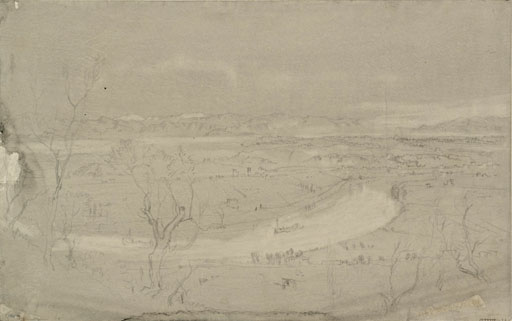Joseph Mallord William Turner View of the River Tiber, Rome, from the Villa Madama on Monte Mario 1819
Image 1 of 2
Joseph Mallord William Turner,
View of the River Tiber, Rome, from the Villa Madama on Monte Mario
1819
Joseph Mallord William Turner 1775–1851
View of the River Tiber, Rome, from the Villa Madama on Monte Mario 1819
D16342
Turner Bequest CLXXXIX 16
Turner Bequest CLXXXIX 16
Pencil and grey watercolour wash on white wove ‘Valleyfield’ paper, 231 x 367 mm
Stamped in black ‘CLXXXIX 16’ bottom right
Stamped in black ‘CLXXXIX 16’ bottom right
Accepted by the nation as part of the Turner Bequest 1856
Exhibition history
1904
National Gallery, London, various dates to at least 1904 (268).
1981
Turner’s First Visit to Italy, 1819: Watercolours from the Turner Bequest, Loaned by the British Museum, Tate Gallery, London, April–October 1981 (no catalogue).
References
1904
E.T. Cook and Alexander Wedderburn (eds.), Library Edition: The Works of John Ruskin: Volume XIII: Turner: The Harbours of England; Catalogues and Notes, London 1904, no.268, pp.378, 622, as ‘Rome: The Tiber and the Apennines’.
1909
A.J. Finberg, A Complete Inventory of the Drawings of the Turner Bequest, London 1909, vol.I, p.562, as ‘The Tiber and the Apennines. 268, N.G.’.
1914
Thomas Ashby, ‘Turner in Rome’, Burlington Magazine, vol.24, no.130, January 1914, p.223 note 6.
1920
D[ugald] S[utherland] MacColl, National Gallery, Millbank: Catalogue: Turner Collection, London 1920, p.87.
Some of the most famous panoramas of Rome could be seen from the heights of Monte Mario, a hill to the north of the city. John Chetwode Eustace, author of A Classical Tour in Italy described the view from the Villa Mellini (now the Rome Observatory) on the summit of the hill:
The Tiber intersecting the city and winding through rich meadows; the Prata Quintia and Prata Mutia, fields still bearing their names, the trophies of Roman virtue and Roman heroism; the Pons Milvius with its tower, and the plains consecrated by the victory of Constantine; the Vatican Palace with its courts and gardens; the Basilica of St Peter with its portico, its obelisk, and its fountains, the Campus Martius covered with the churches, squares and palaces of the modern city; the seven hills strewed with ruins of the ancient; the walls with their towers and galleries; the desert Campagna, with Mount Soracte rising apparently in the centre; and the semi-circular sweep of mountains tinged with blue or purple, now bright with the sun, now dark in the shade, and generally gleaming with snow – such is the varied and magnificent scene spread out before the traveller, while reposing on the shaded terrace of Villa Mellini.1
This sketch depicts the view from the Villa Madama, a sixteenth-century estate built for the Medici family on the eastern slopes, famous for its garden loggia designed by Raphael. The composition encompasses a sweep of approximately ninety degrees with the central focus of the dramatic ox-bow curve of the River Tiber as it loops from the Ponte Molle on the left towards the city on the right. Like many drawings within this sketchbook, it has been executed over a washed grey background. Turner has created areas of pale highlights by lifting or rubbing through to the white paper beneath, principally to delineate the twisting course of the river and the lightness of the snow-covered mountains in the distance.
Turner made a large number of studies repeating related views from the Villa Madama and Monte Mario, see folios 31, 48, 57 and 60 (D16357, D16377, D16388, D16391; CLXXXIX 31, 48, 57, 60) and loose sheets (D16350, D16352; CLXXXIX 24, 26). Further sketches can also be found in the St Peter’s sketchbook (Tate D16174–D16177; Turner Bequest CLXXXVIII 9a–11) and the Small Roman C. Studies sketchbook (Tate D16444; CXC 33a). The composition is also very similar to James Hakewill’s drawing of the same subject, View of the Ponte Molle and the Tiber, looking across the Campagna to the Sabine Mountains 1816.2 The large number of detailed studies devoted to the subject suggests that Turner was seriously exploring the idea as a potential theme for a painting. Indeed, the visual motif of the sweeping bend of river is repeated in a later oil study, Hill Town on the Edge of the Campagna ?1828 (Tate, N05526).3
Finberg described Turner’s 1819 views from Monte Mario as ‘exquisite’ views which had ‘long been among the most admired of the drawings exhibited in the Turner Water-Colour Rooms at the National Gallery’.4
Verso:
?Blank (pasted to mount).
Nicola Moorby
July 2009
How to cite
Nicola Moorby, ‘View of the River Tiber, Rome, from the Villa Madama on Monte Mario 1819 by Joseph Mallord William Turner’, catalogue entry, July 2009, in David Blayney Brown (ed.), J.M.W. Turner: Sketchbooks, Drawings and Watercolours, Tate Research Publication, December 2012, https://www


